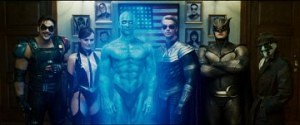 Often considered a difficult work to adapt due to its complicated themes and story structure as well as the expense required to recreate its alternate history world of the 1980s, director Zack Snyder’s film version of Alan Moore and Dave Gibbon’s Watchmen is perhaps the most faithful adaptation of the groundbreaking graphic novel possible. The question that remains, however, is whether Watchmen is the best possible movie to be made from the material.
Often considered a difficult work to adapt due to its complicated themes and story structure as well as the expense required to recreate its alternate history world of the 1980s, director Zack Snyder’s film version of Alan Moore and Dave Gibbon’s Watchmen is perhaps the most faithful adaptation of the groundbreaking graphic novel possible. The question that remains, however, is whether Watchmen is the best possible movie to be made from the material.
Originally published as a 12-issue miniseries in 1985, Watchmen presented readers with superheroes far more complex than had previously been seen in comics. These were individuals with complex psychologies, who were sometimes driven to put on costumes and fight crime not so much out of altruism but for deeper and darker motives. Only one, the blue glowing Dr. Manhattan (Billy Crudup), has any sort of super power, though his mere presence has escalated Cold War tensions to a point that made the Cuban Missile Crisis look like a pleasant disagreement. Although their activities were outlawed by an act of Congress a decade earlier, these heroes – the masked Rorschach (Jackie Earle Haley) convinces Night Owl (Patrick Wilson) and Silk Spectre (Malin Akerman) to reluctantly pull out their old colorful outfits when one of their own, the Comedian (Jeffrey Dean Morgan), is murdered. However, they soon discover that the Comedian’s murder is just the harbinger of a much bigger danger.
Going into the theater, I wanted to like, if not love, Watchmen. I was rooting for Snyder to hit the ball out of the park. As a fan of the graphic novel, I have spent nearly the last two decades watching various studios and directors struggle to bring the story to the big screen. I have read a majority of the screenplays produced in these attempts, smiling when they seemed to understand a certain aspect of the story, wincing when they clearly missed the point of another. So I grant that I may be, in part, a victim of my own expectations.
It is evident that Snyder gets the material. He has managed to keep Moore’s major themes and wrestled the flashback-laden, at times labyrinthine, plotline to the screen with minimal cuts and changes. Films have a standard three act structure, while the graphic novel is composed of 12 separate issues that each have their own introduction, rising action and climax. Miraculously, though, the screenplay – by long time comics-to-film adapter David Hayter (X-Men and X-Men 2) and newcomer Alex Tse – flows through the story, never feeling as episodic as it could have easily become. Snyder even parallels the original comics’ deconstruction of then-contemporary comic books tropes with a similar commentary on current comic book film conventions, mostly through production and costume design.
 But there are times in the film when things feel too reverential, where Snyder seems so intent in bring the comics’ pages and panels to 3-D life on the screen that he forgets to allow these scenes to breath with a life of their own. These don’t seem to take full advantage of film as a different medium. It was a problem that also plagued the first two Harry Potter installments, though Snyder doesn’t succumb to it as much as Chis Columbus did on those two films.
But there are times in the film when things feel too reverential, where Snyder seems so intent in bring the comics’ pages and panels to 3-D life on the screen that he forgets to allow these scenes to breath with a life of their own. These don’t seem to take full advantage of film as a different medium. It was a problem that also plagued the first two Harry Potter installments, though Snyder doesn’t succumb to it as much as Chis Columbus did on those two films.
Snyder’s cast does a mixed job at bringing to life the complicated, oft-times psychologically damaged, characters of the graphic novel to life. Haley probably has the biggest job in bringing the fan-favorite Rorschach to life and rises to the task. Although the script underplays his background somewhat, Haley manages to sketch in the blank spots through his portrayal. Not so strong is Akerman as Silk Specter. Her character’s background is equally compressed, but she doesn’t seem to exude the world-weariness that we are told her character feels after living the life she has lead. The minimal amount of time the script devotes to her relationship with her mother, the first Silk Specter played under loads of latex wrinkles by Carla Gugino, also doesn’t help her.
Don’t let my minor problems with the film discourage you from seeing it, though. For what it does accomplish, Watchmen is both a storytelling and visual wonder. It is a sprawling spectacle that demands to be seen on the big screen. While the film does manage to stand on its own, diehard fans will undoubtedly still have their nitpicks about certain elements that got lost in the translation to the big screen. But that is an understandable part of the process of adapting a story from one medium to another. Perhaps some of those small grace notes will be restored in the already announced three-hour Director’s Cut DVD release. In any event, I am sure that there is enough material for fans to debate the relative merits of both book and film for some time to come.



